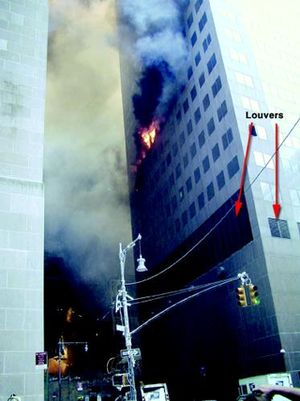In this five-part series, I expose and disprove NIST's false claims in five critically important areas:
Part 1: Burned-Out Fire
Part 2: Magical Thermal Expansion
Part 3: Missing Shear Studs
Part 4: Fictitious Debris Damage
Part 5: Non-Existent Diesel Fuel Fire
Note: Quotes from NIST's WTC 7 reports are shown in Bold Light Blue.
As early as May 2002, the Federal Emergency Management Agency (FEMA) acknowledged the problem with the diesel fuel fire hypothesis for the collapse of World Trade Center Building 7, writing: “Although the total diesel fuel on the premises contained massive potential energy, the best hypothesis has only a low probability of occurrence. Further research, investigation, and analysis is needed to resolve this issue.” — FEMA, Chapter 5, page 31
Nonetheless, in its June 2004 Progress Report, NIST continued the diesel fuel fire hypothesis, despite having the data that proved such a fire did not exist in the building: “The presence of a fuel distribution system and the possibility of damage at the south face from WTC 1 debris impact, indicates that fires may have been present on Floor 5.” — NIST Progress Report, Appendix L, page L-51
NIST's Shyam Sunder misinformed Popular Mechanics in its March 2005 article “Debunking the 9/11 Myths” by telling the writers that there was a fire on Floor 5 of WTC 7 that lasted up to seven hours. There was no fire reported on that floor and no reason to think there was one.
The magazine wrote: “Second, a fifth-floor fire burned for up to 7 hours. 'There was no firefighting in WTC 7,' Sunder says. Investigators believe the fire was fed by tanks of diesel fuel that many tenants used to run emergency generators. Most tanks throughout the building were fairly small, but a generator on the fifth floor was connected to a large tank in the basement via a pressurized line. Says Sunder: 'Our current working hypothesis is that this pressurized line was supplying fuel for a long period of time.'”
A month later, in April 2005, NIST published an interim report on WTC 7 that said essentially the same thing: “This finding allows for the possibility, though not conclusively, that the fuel may have contributed to a fire on Floor 5.” — NIST Part IIC, April 5, 2005, page 38
Even as late as the first quarter of 2007, the debate about diesel fuel fire was still raging, with talk of 40,000 gallons of diesel fuel playing a role in the destruction of WTC 7. Yet no one had bothered to research the details of the diesel fuel fire hypothesis.
The above-mentioned FEMA report's Chapter 5 contains a great deal of basic information about WTC 7. It explains that all the tanks, pipes, and generators were in the west end of the building, except for the four SSB generators in the northeast section of Floor 5. The supply line to these generators was the only possible source of a fuel oil fire in the east end of WTC 7, where the collapse purportedly began.
Based on that information, I wrote the following post on the JREF forum on March 7, 2007: “There were no diesel fuel-fed fires in the east part of WTC 7 where the initiating event occurred that led to the collapse.”

The east generator room was in the northeast corner of WTC 7, on the fifth floor. The supply pipe for the east generator room was north of the wall that is on the north side of the core area, about 90' from the south side of the building (see FEMA, pages 14-15).
Also, if the generators [and the pump feeding fuel oil to them] were running, the louver vents would have been open (see FEMA, page 29).
If there were a fire in this room, I wrote in my JREF post, smoke would have been pouring out through the vents.
My full post on the JREF forum, titled “There were no diesel fuel fires or debris damage in the area of the initiating event that led to the global collapse of WTC 7,” can be found here.
The following is from my post at the Loose Change forum on November 15, 2007: “The northeast generator room was in the NE corner of WTC 7 on the fifth floor. The supply pipe for the generator room was north of the core area, about 90 feet from the south side of the building and at the opposite end of the building from where the debris damage was. All the other diesel tanks, pumps, supply pipes, and generators were in the west half of WTC 7. If the generators were running, and the intake/cooling fans were on, the louver vents would be open. If there were a fire in this room, smoke would be pouring out through the cooling air exhaust vents. If the louvers were closed, a fire would not have sufficient oxygen to burn hot enough to be a factor in the collapse.”
My full Loose Change forum post, titled “There were NO diesel fuel fires in or near the area of initiating event that led to the implosion of WTC 7,” can be found here.
Finally, in December 2007, NIST conceded that the diesel fuel fire hypothesis had no merit. NIST wrote: “The working hypothesis is based on an initial local failure caused by normal building fires, not fires from leaking pressurized fuel lines or fuel from day tanks.” — NIST – World Trade Center Disaster Study, December 18, 2007, page 6
It seems that NIST not only read my JREF and/or Loose Change posts, but took my conclusions to heart. For, in its final report, NIST paraphrased my words a total of 12 times. I will cite each of these 12 paraphrases below.
NIST's NCSTAR 1-A Final Report on WTC 7
(1) An under-ventilated fire, in which the air handling system was turned off and the louvers were closed. The initial fuel burning rate was fit to the air availability. Result: The sustained air temperatures were not high enough to compromise the structure. — page 30 [PDF page 72]
(2) An under-ventilated fire, in which the air handling system was turned off, but the louvers were open. Result: Smoke would have exhausted through the east louvers, and the imagery showed no such effluent. — page 30 [PDF page 72]
(3) The worst-case scenarios associated with fires being fed by the ruptured fuel lines, (b) would have produced large amounts of visible smoke that would have emanated from the exhaust louvers. No such smoke discharge was observed. — page 49 [PDF page 91]
(4) Simulation of hypothetical, worst-case fire scenarios on these floors showed that pool fires, associated with ruptured diesel fuel lines, (c) would have exhausted smoke from the exhaust louvers, which was not observed. — page 51-52 [PDF pages 93-94]
NIST's NCSTAR 1-9, Vol. 1
(5) “However, if a large fire penetrated a plenum wall and if the louvers were open, flames might have been visible, and smoke might have emanated from the exhaust openings. NIST found no photographic records or eyewitness accounts of smoke or fires that could be attributed to fires on these two floors.” — page 51 [PDF page 95]
(6) “Simulations showed that pool fires associated with ruptured diesel fuel lines . . . (c) would have exhausted smoke from the exhaust louvers, in conflict with the photographic evidence which showed none.” — page 355 [PDF page 399]
NIST's NCSTAR 1-9, Vol. 2
(7) “Result: The FDS simulation showed that the natural flow from the fire plume would have been out of the louvered openings on the east side of the building in a very short time. Significant plumes of smoke would have been seen emerging from the building within a few minutes of ignition, contradicting the visual evidence.” — page 372 [PDF page 34/438 in combined 1-9 Vol. 1 and Vol. 2]
(8) “A broad range of hypothetical, extreme fires on the 5th floor did not produce a fire scenario that was consistent with the visual evidence that would have threatened the load bearing capacity of Columns 79, 80, or 81.” — page 374 [PDF page 36/440]
(9) “[T]hese fires would have exhausted smoke from the exhaust louvers. No such emanation was observed.” — page 387 [PDF page 49/453]
(10) “Additionally, such fires would have produced large amounts of visible smoke that would have emanated from the exhaust louvers; however, no such smoke discharge was observed.” — pages 613-614 [PDF pages 275-276/679-680]
(11) “The worst-case fire scenarios associated with fires being fed by the ruptured fuel lines (b) would have produced large amounts of visible smoke that would have emanated from the exhaust louvers. No such smoke discharge was observed.” — page 619 [PDF page 281/685]
(12) “Simulation of hypothetical, worst-case fire scenarios on these floors showed that pool fires associated with ruptured diesel fuel lines, (c) would have exhausted smoke from the exhaust louvers, which was not observed.” — pages 621-622 [PDF pages 283-284/687-688]
See NIST's November 20, 2008, NCSTAR Final Report on WTC 7, 1-9, Vol. 1 and 2.
References:
FEMA Report FEMA 403 Chapter 5, WTC 7
Progress Report June 2004 Progress Report Appendix L
NCSTAR 1A Final Report on the Collapse of World Trade Center Building 7
NCSTAR 1-9, Vol.1 and Vol. 2 Structural Fire Response and Probable Collapse Sequence of World Trade Center Building 7




